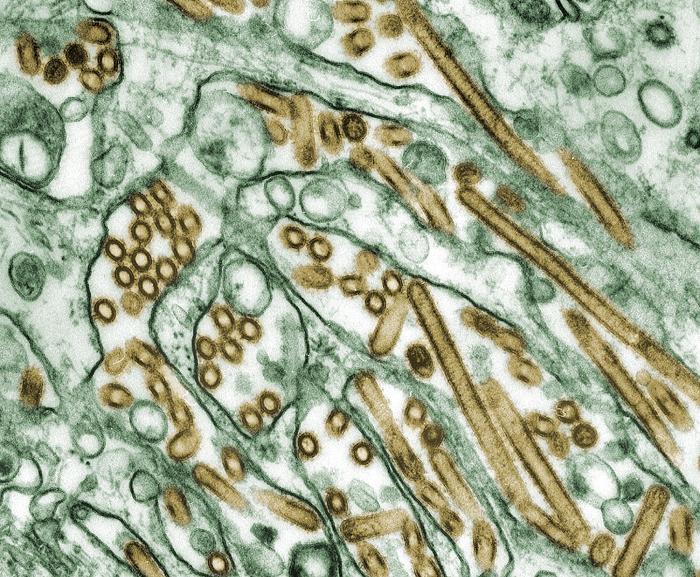In a new development that could diffuse some of the controversy surrounding work with lab-modified flu viruses, researchers unveiled a way to make the work safer by adding a molecular component that would enable human lung cells to demolish the viruses before they can infect.
The strategy harnesses microRNAs (miRNAs) to work as a "molecular biocontainment" system that the developers say can augment traditional lab biocontainment procedures for work with dangerous pathogens. The team based at Mount Sinai Medical Center in New York published their findings in the Aug 11 edition of Nature Biotechnology.
Some influenza researchers are conducting experiments on lab-engineered H5N1 viruses to learn more about what might enable them to become airborne and spread more easily among humans. The work is controversial, due to the risk of accidental or intentional lab release and concerns that publication of the study details might allow rogue labs or individuals to replicate the work, which could pose a bioterror threat.
The issue led to a voluntary global moratorium starting last year on H5N1 gain-of-function studies and prompted governments and scientists to rethink how the work is done and how to ensure its safety. At a 2-day meeting on H5N1 research issues at National Institutes of Health (NIH) headquarters in Washington in December, scientists said they were open to methods for making the work safer, but they aired concerns about genetic changes interfering with the dynamics they want to study between the virus and respiratory cells.
A group of researchers last week outlined similar gain-of-function experiments on the new H7N9 virus, reigniting the debate. In their statement they also spelled out several risk-mitigation steps, one of which was modifying the experiment design and using alternative approaches, such as attenuated strains, to reduce the risk.
The new strategy mimics a system that plants use to destroy viral attackers, according to a Mount Sinai press release. Plants have small inhibitory microRNAs (siRNAs) that latch onto a virus and cleave it, but the human body uses miRNAs to maintain cell health, not fight viruses. The researchers found that the molecule turns into a plant-like attacker when they alter a viral genome by adding a binding site for miRNA.
The group identified a specific miRNA (miR-192) that is found in human and mouse lung cells, but not in those of ferrets. When they added binding sites for miR-192 to the H5N1 genome and used it to infect mice, the animals' lung cells destroyed the virus. However, the engineered H5N1 virus didn't decrease transmission among ferrets, which is important, because the animals are an important model for studying H5N1 and other viruses.
They also found that the approach works with other influenza A viruses. Benjamin tenOever, PhD, a study author and professor in the departments of medicine and microbiology at Mount Sinai, said in the press release that it's clear that the strategy can be applied to any virus.
"The only requirements are that we need a miRNA that is present in humans, but not in the model system where we want to study the virus, such as in ferrets," he said. "We also need a viral genome that permits insertion of miRNA target sites."
The strategy might also be useful for other highly pathogenic RNA viruses such as Ebola and SARS, the group wrote.
Once viruses are altered to include the miRNA target sites, they can replicate indefinitely to provide material for research in other labs. "There is no need to continually go back to the drawing board," tenOever said.
Microbiologist Katie Ballering, PhD, told CIDRAP News that the new technique would enhance biosafety. She said the chance of a lab worker being exposed under enhanced biosafety level 3 (BSL-3) is already low, and that the new technique would further drive down the risk.
Ballering is a senior scientist with the BioWatch team at the University of Minnesota's Center for Infectious Disease Research and Policy, publisher of CIDRAP News, and also a post-doctoral fellow in the Great Lakes Regional Center of Excellence Biosafety Scholar/Research Program at the University of Chicago.
She said the authors addressed the risk of escape mutations, and wrote that the risk is low. Though Ballering said she agrees that the risk is low, the possibility will likely create another step for researchers seeking to use this methodology, who would need to show that the strain they propose using still carries the attenuating mutations before they start their work. She projected that the NIH and local institutional biosafety committees would have to think about what the requirements would be for such proof, such as a simple sequence or evidence of function in cell culture.
This and other policy issues need to be resolved before the technique can be used as a solution to gain-of-function research problems, Ballering said. One part of the gain-of-function debate that the new method doesn't resolve is the biosecurity concern related to publication of the research, she added.
"Overall, though, I think that this group should be commended for dedicating themselves to finding additional biosafety measures to ensure that this research can move forward," she said. "I think that this is a large and important step in that process."
Langlois RA, Albrecht RA, Kimble B, et al. MicroRNA-based strategy to mitigate the risk of gain-of-function influenza studies, letter. Nat Biotechnol 2013 Aug 11 [Abstract]
See also:
Aug 12 Mount Sinai press release
Aug 7 CIDRAP News story "Scientists air topics for H7N9 gain-of-function research"






















